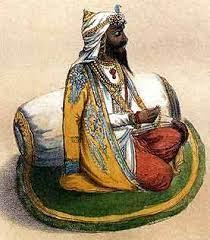Early Life Of Kharak Singh:
He was born on 22 February 1801 in Lahore, Punjab. He was the first son of Ranjit Singh and his second wife Datar Kaur Nakai. His mother was the daughter of Ran Singh Nakai, third ruler of the Nakai Misl. The prince was named by his father "Kharak" (ਖਰਕ) which means 'Wielder of the Sword' he was named after the unconquerable warrior mentioned in Dasam Granth. According to Gyani Sher Singh, Ranjit Singh knew the entire Dasam Granth by heart. It was his birth that persuaded his father to proclaim himself the Maharaja of Punjab.
He married four times. In 1812, at the age of 11 he was married to Chand Kaur Kanhaiya, daughter of Sardar Jaimal Singh, chief of the Kanhaiya Misl. Their son Nau Nihal Singh was born in 1821. In 1816, the prince was married to Bibi Khem Kaur Dhillon, a Jat Sikh daughter of Jodh Singh Kalalvala and granddaughter of Sahib Singh Dhillon. After the Second Anglo-Sikh War in 1849, Bibi Khem's jagirs were reduced by the British raj due to her anti-British role in the war. His third wife was, Kishan Kaur Samra, a daughter of Chaudhari Raja Singh of Amritsar of the Samra clan; they were married in 1818. She was the only queen to live after the fall of the Sikh Empire in 1849, had an annual pension paid by the British Raj of RS 2324 and died in Lahore in 1876 while living at the Lahore Fort. His last wife, Inder Kaur Bajwa was married by proxy in a "chadar dalna" ceremony, in 1815. She was a relative of Chet Singh Bajwa.
He was born on 22 February 1801 in Lahore, Punjab. He was the first son of Ranjit Singh and his second wife Datar Kaur Nakai. His mother was the daughter of Ran Singh Nakai, third ruler of the Nakai Misl. The prince was named by his father "Kharak" (ਖਰਕ) which means 'Wielder of the Sword' he was named after the unconquerable warrior mentioned in Dasam Granth. According to Gyani Sher Singh, Ranjit Singh knew the entire Dasam Granth by heart. It was his birth that persuaded his father to proclaim himself the Maharaja of Punjab.
He married four times. In 1812, at the age of 11 he was married to Chand Kaur Kanhaiya, daughter of Sardar Jaimal Singh, chief of the Kanhaiya Misl. Their son Nau Nihal Singh was born in 1821. In 1816, the prince was married to Bibi Khem Kaur Dhillon, a Jat Sikh daughter of Jodh Singh Kalalvala and granddaughter of Sahib Singh Dhillon. After the Second Anglo-Sikh War in 1849, Bibi Khem's jagirs were reduced by the British raj due to her anti-British role in the war. His third wife was, Kishan Kaur Samra, a daughter of Chaudhari Raja Singh of Amritsar of the Samra clan; they were married in 1818. She was the only queen to live after the fall of the Sikh Empire in 1849, had an annual pension paid by the British Raj of RS 2324 and died in Lahore in 1876 while living at the Lahore Fort. His last wife, Inder Kaur Bajwa was married by proxy in a "chadar dalna" ceremony, in 1815. She was a relative of Chet Singh Bajwa.
Early Life Of Kharak Singh:
He was born on 22 February 1801 in Lahore, Punjab. He was the first son of Ranjit Singh and his second wife Datar Kaur Nakai. His mother was the daughter of Ran Singh Nakai, third ruler of the Nakai Misl. The prince was named by his father "Kharak" (ਖਰਕ) which means 'Wielder of the Sword' he was named after the unconquerable warrior mentioned in Dasam Granth. According to Gyani Sher Singh, Ranjit Singh knew the entire Dasam Granth by heart. It was his birth that persuaded his father to proclaim himself the Maharaja of Punjab.
He married four times. In 1812, at the age of 11 he was married to Chand Kaur Kanhaiya, daughter of Sardar Jaimal Singh, chief of the Kanhaiya Misl. Their son Nau Nihal Singh was born in 1821. In 1816, the prince was married to Bibi Khem Kaur Dhillon, a Jat Sikh daughter of Jodh Singh Kalalvala and granddaughter of Sahib Singh Dhillon. After the Second Anglo-Sikh War in 1849, Bibi Khem's jagirs were reduced by the British raj due to her anti-British role in the war. His third wife was, Kishan Kaur Samra, a daughter of Chaudhari Raja Singh of Amritsar of the Samra clan; they were married in 1818. She was the only queen to live after the fall of the Sikh Empire in 1849, had an annual pension paid by the British Raj of RS 2324 and died in Lahore in 1876 while living at the Lahore Fort. His last wife, Inder Kaur Bajwa was married by proxy in a "chadar dalna" ceremony, in 1815. She was a relative of Chet Singh Bajwa.
0 Commentaires
0 Parts
0 Aperçu



